Kitchen cabinets in typical 1930s, 1940s and 1950s UK kitchens
In the 1930s, 40s and early 50s there were no fitted kitchens as we know them today, although a kitchen cabinet of the sort seemed to be in all the 'modern' kitchens of the time. It was the forerunner of today's fitted kitchens as it had cupboards, shelves and drawers integrated into a single piece of furniture. This page describes the different styles and their clever designs with a place for all standard kitchen equipment.
____
By the webmaster, based childhood observations, discussions with people who lived with these units and additional research
These kitchen cabinets were of course all made in the 1930s as nothing non-essential was made in the wartime of the 1940s or the austerity afterwards. All were made from wood by several manufacturers who gave them their own unique names. Ours was called the 'Easy Cabinet', my cousin's was the 'Maid Saver' and my friend's the 'Daintymaid'. If yours was called something different, please let me know.
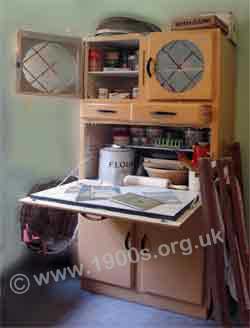
Appearance of the 1940s kitchen cabinets
Our Easy Cabinet was made of easy-clean varnished wood. It was of a medium colour which would have been called 'light' in those days of dark wood almost everywhere. I suspect that it came with the house when it was built in the 1930s as there were identical ones in other kitchens along the road. Remember there were no shiny plastics or stainless steel.
The photo at the top of the page shows the cabinet combination which was closest to ours from all those I have seen in museums. Museums, naturally enough, exist to display what they have, which is why so many doors and drawers are open and so many objects are propped up. In a real 1940s kitchen, everything would have been tidied away after use.
Ovens were free-standing rather than built-in and there were of course no fridges.
The wide range of kitchen cabinets
The following photographs which I took in various museums illustrate the wide variety of kitchen units before today's built-in ones. Few, if any, would have been imported as wood was plentiful and relatively cheap in the UK at the time. How different from today! Probably they would have been made fairly locally and coloured and/or varnished before sale. I never saw any with the marks of a home paint brush.
Quite apart from colour, note that the top cupboards vary in depth: in some units they are the same depth as the lower cupboards and shelves and in others they are shallower. A white enamelled board for rolling out pastry was considered absolutely essential as every housewife was expected to make pastry. Note that it was always hidden when not in use: either it pulled down and out as shown in the first photo or it slid out and back in as shown in the last photo.
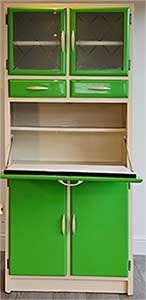
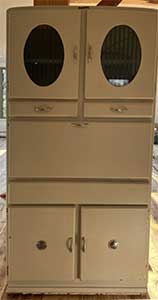
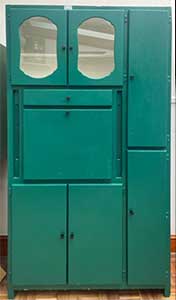
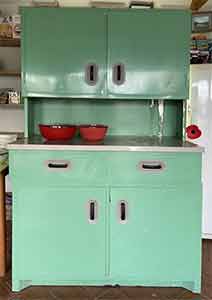

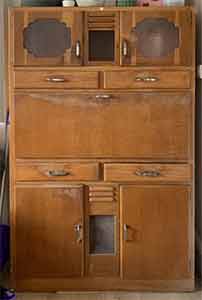
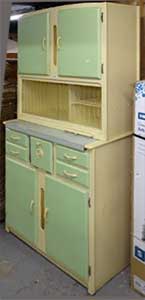
Features
The pastry board in our Easy Cabinet was the slide-out style, and the space above it closed and opened with a rolling arrangement.
There was a separate, matching shelved cupboard which butted onto the main cabinets, somewhat as shown in the third of the above photos. It was the same height as the Easy Cabinet and including a tall, narrow slot for an ironing board and broom adjacent to various shelves. All sorts of things were poked into the shelves including the electric iron. There was a space for everything.
| sources | webmaster | contact |
Text and images are copyright
If you can add anything to this page or provide a photo, please contact me.



